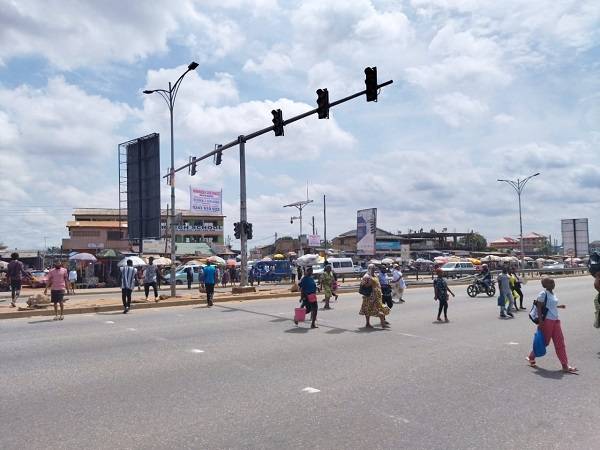Since Monday, the world has been marking the 7th UN Global Road Safety Week, an important event that presents stakeholders with a vital opportunity to focus on the risks of road traffic and to take action to improve safety on our roads.
The biennial campaign, hosted by the World Health Organization (WHO) on the theme “Sustainable Transport”, makes a case for governments to rethink mobility and facilitate a shift to walking, cycling and using public transport.
By investing in these options, it is expected that there would be a healthier and more equitable society. Additionally, it calls on countries to prioritize road safety for all road users, especially those most vulnerable, including children, persons with disabilities, and pedestrians. When designed with these users in mind, it is believed that road networks could create safe environments for all to move around cities with ease.
The slogan, #RethinkMobility, highlights the importance of transforming current transportation systems to prevent road crashes and promote safe mobility.
Global situation
With road traffic injuries continuing to be a leading cause of death and disability worldwide, the importance of spreading awareness about road safety and accident prevention has never been more crucial.
Despite the many efforts that have been put in place over the years, road traffic injuries continue to pose a significant threat to people aged 5-29 years, according to the WHO.
The organisation estimates that 1.3 million deaths occur each year, and as many as 50 million people are injured. Incredibly, one out of every four deaths among pedestrians and cyclists can be attributed to road traffic.
With the Decade of Action for Road Safety 2021-2030 already underway, the Global Plan reflects a bold target of reducing road traffic deaths and injuries by 50% within a decade.
This is an ambitious goal, but one that can be achieved by addressing the whole transport system by ensuring safe roads, vehicles, and behaviours, as well as improving emergency care services.
Ghanaian version
In Ghana, we see the heartbreaking toll that road crashes continue to take on the country’s citizens. Data provided by the National Road Safety Authority (NRSA) indicates that 2,373 people lost their lives in 14,960 road crashes last year, with an additional 15,690 people injured.
A total of 25,754 vehicles were involved in crashes, with 8,645 commercial vehicles, 11,677 private vehicles, and 5,432 motorcycles represented.
Additionally, 2,680 pedestrians were struck and injured while walking along or crossing the roads.
It is alarming to note that occupants of motorcycles accounted for nearly half of all fatalities, with 974 deaths in 2022 alone.
Although there was some decrease in the data when compared to the previous year, the numbers underscore the urgent need for effective solutions to promote safe, sustainable transportation for all Ghanaians
The road conditions in some parts of the country are not ideal, with numerous issues that can make travelling a risky endeavour for road users.
Some of the major problems in the country in terms of road safety are the breakdown of traffic lights and faint road markings, making it difficult for drivers to navigate through the roads. Moreover, broken down street lights can result in dark and unsafe roads for pedestrians and other users.
Streetlights/ traffic signals
In December 2021, the NRSA expressed concern about the general state of traffic signals and streetlights on some of the urban road networks across the country. According to the NRSA, these issues increase the vulnerability of road users, especially pedestrians, to road traffic crashes and their associated injuries and deaths.
The Authority identified non-functional lights across the country that same year. Greater Accra accounted for the highest percentage of non-functional traffic lights at 48%, followed by Ashanti, Central, and Western regions. Although some of the light and traffic signals may have been fixed, the issue persists as media houses continue to report on such issues.
Footbridges/ pedestrians
For well over a month, pedestrians have been left vulnerable to the whims of reckless drivers due to the inoperative second traffic light after the Las Palmas junction at Lapaz in the national capital Accra. Even though a handful of traffic wardens occasionally show up to regulate the traffic flow in the evenings, their presence is not consistent. Furthermore, the few footbridges scattered along the stretch of the road are uncomfortably spaced, making it inconvenient for pedestrians to use them. With each passing day, the wire mesh that serves as a safety barrier in the median of the road dwindles, pushing pedestrians to improvise new perilous routes to cross the busy street.
For anyone who has resided in Ghana in the last half-decade, the Madina incident comes to mind when footbridges are mentioned. In a bid to reduce pedestrian Knockdowns, these structures were constructed following several public protests, but their perceived inconvenience made pedestrians reluctant to use them. This is a classic example of the need to marry convenience with safety in the development of road safety interventions.
Cycling
This year’s celebration also sheds light on cycling safety. In Accra, traffic congestion is a common occurrence, and it’s not uncommon to see pedestrians and cyclists struggling to navigate their way through busy roads. However, despite the numerous benefits of cycling, it often receives more attention when it’s linked to sports. Ghana has hosted several cycling tournaments. But when it comes to transportation, cycling is seldom mentioned as a mode of transport. This is unfortunate because it is an eco-friendly and efficient way to reduce traffic and keep individuals healthy.
Like in Denmark’s capital city, Copenhagen,
investment in biking infrastructure would ensure that roads in Accra and other city centres are re-engineered to accommodate bicycles. This will provide alternative transportation options and decongest the roads while improving safety for pedestrians and cyclists alike.
One may say that suggestion is a lofty idea given that the designated lanes for Rapid Bus Transit have proved futile in achieving their purpose of promoting mass transportation and minimizing traffic jams.
Time to rethink mobility
The 7th UN Global Road Safety Week is a time for individuals, governments, and stakeholders to come together and rethink mobility. With road traffic injuries being a major cause of death and disability around the world, it is crucial to prioritize sustainable transport as a way of preventing road crashes and promoting safe mobility.
The governments can help by prioritizing walking, cycling, and public transport. This can be done by providing dedicated bike lanes and pedestrian walkways and having constant public awareness campaigns on road safety. Individuals can also play a part by obeying traffic laws, wearing seatbelts, avoiding distractions while driving, and limiting their speed. Additionally, prioritizing walking and cycling could reduce carbon emissions and promote healthier lifestyles.
By prioritizing sustainable transport, we can reduce the number of road traffic injuries and promote safe mobility. It’s time for everyone to #RethinkMobility and work together to create a safer and more sustainable future.
BY JONATHAN DONKOR




















Discussion about this post